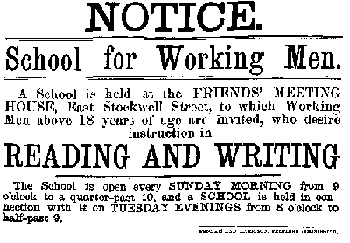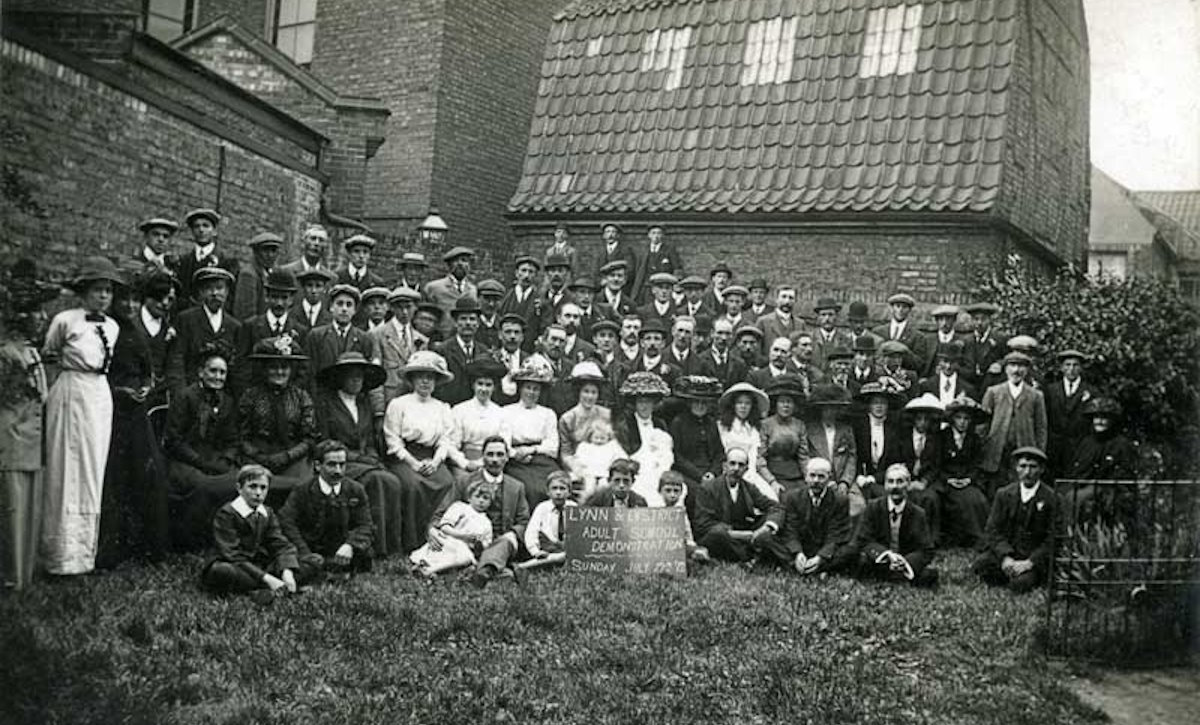Adult schools and the making of adult education. The adult school movement starting in the late 1790s, while for most of the time only small in numbers, was a significant element in the making of adult education in Britain. This article briefly surveys the history and impact of such schools.
contents: introduction · the emergence of adult schools · rapid growth and decline · conclusion · bibliography · how to cite this article
In the development of non-conformist Christianity from John Wycliffe and the Lollards on, direct access for all to the Bible was stressed. With it came the need to be able to read – and an acceleration of Church efforts to educate around literacy. With the formation of the Society for Promoting Christian Knowledge (SPCK) in 1699 we see, for the first time, the Church of England making an attempt to encourage the formal teaching of adults to read. It was an initiative that was not generally followed up in England, but does appear to have taken root in Scotland and Wales (Kelly 1970: 65-69). Some 95 SPCK schools and a similar number of Dissenting schools were established between 1699 and 1937 in Wales. However, such courses did come come under some criticism for their cost, length and conduct in the English language.
In response to the criticisms of the early schools a pioneering new form emerged – the Welsh Circulating Schools – under the influence of Rev Griffith Jones. These schools grew with some speed in the first half of the eighteenth century. They used Welsh language Bibles, prayer books and materials; were open to ‘all Sorts that desire it… to be kindly and freely taught for three months’ (described in the Circulating Welsh Charity Schools Annual Report for 1742-3 – Kelly 1970: 67); and could be attended by adults as well as young people. Adults could come on weekday evenings or to Sunday Schools. During the period 1737-1761 there appear to have been some 3000 schools conducted with over 150,000 scholars. In addition to these efforts there were also significant initiatives in the Scottish Highlands and within the Methodist societies that emerged in the mid eighteenth century. The massive growth of Sunday schooling from the 1780s onwards, while having an orientation to the instruction of children did, in some areas such as Northern England and Wales, encourage adult participation. Sunday school workers such as Hannah More also put a considerable amount effort into work with adults and the provision of cheap repository tracts. However, in all these efforts work with adults arose ‘as subsidiaries to the teaching of children’ (Kelly 1970: 79)
The development of adult schools

The numbers of schools was relatively small – and there appears to have been a decline in numbers to the mid-century. However, there was a slow revival of adult schools from around 1850. In particular the efforts of two Quaker businessmen in Birmingham – Joseph Sturge and William White – were of significance. Sturge’s Severn Street school added evening classes in arithmetic, geography and grammar. As well as broadening the range of subject areas covered these schools, largely associated with Quakers, made a conscious effort to retain participation. There was a growing emphasis on discussion, fellowship and mutual aid activities such as book or library clubs, savings banks, sick funds and temperance societies. By the end of the century there appear to have been around 350 schools involving some 45,000 participants (29,000 of these were associated directly with schools run by the Society of Friends) (Figures from Rowntree and Binns 1903: 33). A National Council of Adult Schools was formed in 1899 to federate existing adult school associations and to promote the work
Rapid growth and decline
As with other forms of working class adult education, there was a rapid jump in participation in the period up to the First World War. By 1909-10 there were some 1900 schools involving over 114,000 adults (this was the peak of participation). A clause in a 1907 statement declared:
It is understood that the Schools shall maintain as fundamental principles:
(a) The reverent study of the Bible as the central feature;
(b) Democratic, unsectarian, and non-party methods of working. (quoted by Hall 1985: 19).
There had been a shift in the activities of adult schools. There was a growing focus on social problems and the significance of religion to the world. The range of activities in this respect included classes, lectures, discussions and study circles on evenings as well as weekends. (For an insight into nature of classes see the extract from Rowntree and Binns [1903] in the archives). There were also developments in associated activities – especially through the growth of adult school holiday homes.
Links were also made with the small number of educational settlements that were established between 1903 and 1918 (ten were founded in the Midlands and North of England). Indeed, it was out of the efforts of adult school workers and the Society of Friends that these institutions largely emerged. Two were residential – Woodbrooke and Fircroft in Selly Oak, Birmingham (for a brief account of Fircroft see Tom Bryan, association and Fircoft College) and the rest were non-residential centres. As Kelly (1970: 261) has commented they had certain ideals in common:
.. they held their primary purpose to be education, not social missionary work; they believed that adult education was fundamentally spiritual in character; and they believed that such education could only be effectively carried on in an atmosphere of fellowship.
These ideals could equally be applied to adult schools.
The decline in numbers attending adult schools set in just before the First Worldd War and accelerated during and after it. Reasons for the decline are not difficult to identify. There was, of course, the direct impact of the war and the sapping away of both teachers and participants. In addition, we see the emergence of other adult education organizations such as the Workers’ Educational Association (WEA). However, the main factor in many peoples’ minds within the movement was the changing mood of the time. The schools retained an emphasis on Bible study and religious exploration. Significantly while male membership dropped dramatically (from nearly 74,000 in 1910 to 9,600 in 1937-8), female membership fell far less quickly (38,000 in 1910 to 17,600 in 1937-8). In other words, in 1910 adult schools were male dominated (by 2 to 1); by 1937 they were largely female preserves (by nearly 2 to 1 again). By 1970 there were just 2000 participants in adult school classes.
Conclusion
Adult schools were the first dedicated educational provision for adults in Britain. Their emphasis on fellowship and the spiritual nature of education was significant and carried into other institutions. Their use of discussion and concern with democratic ways of working was an important element in the making of ‘adult education method’. They shared such concerns with others in the settlement movement and with key figures such as R. H. Tawney in university extension work and the WEA.
Bibliography
Gardiner, A. G. (1923) Life of George Cadbury, London: Cassell.
Hall, W. A. (1985) The Adult School Movement in the Twentieth Century, Nottingham: University of Nottingham, Department of Adult Education.
Kelly, T. (1962; 1970; 1992) A History of Adult Education in Great Britain, Liverpool: Liverpool University Press.
Martin, G. Currie (1924) The Adult School Movement. Its origin and development, London: National Adult School Union.
Pole, T. (1814; 1816) A History of the Origins and Progres of Adult Schools, Bristol: C. McDowell and J. Richardson. (Republished by A. G. Kelley (New York) and Woburn Press (London) 1969). 128 + x pages.
Rowntree, J. W. and Binns, H. B. (1903) A History of the Adult School Movement, London: Headley Brothers.
Acknowledgements: Picture: Adult School Demonstration, Lynn and District Sub-Union. See the discussion on the Kings Lynn Forums. http://www.kingslynn-forums.co.uk/viewtopic.php?f=14&t=3579. The picture of an early poster advertising an adult school is believed to be in the public domain.
How to cite this article: Smith, M. K. (2004) ‘Adult schools and the making of adult education’, The encyclopedia of pedagogy and informal education. [https://infed.org/mobi/adult-schools-and-the-making-of-adult-education/. Retrieved: insert date]
© Mark K. Smith 2004
